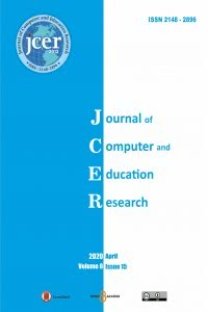Öğretim Teknolojileri Kapsamında Öğretmenlerin Hizmet-İçi Eğitimleriyle İlgili Bir Model Önerisi: Web Tabanlı Hizmet-İçi Mesleki Gelişim Modeli
Öğretmenlere yönelik hizmet-içi eğitim faaliyetlerinin gerçekleştirilmesinde bazı eksiklikler ve aksaklıklar yaşanmaktadır. Bu aksaklıklardan bazıları hizmet-içi eğitimlerin sürekliliğinin sağlanamaması, eğitim öğretim faaliyetleri dışında yüz yüze hizmet-içi eğitimde yaşanan zaman sıkıntısı, hayat boyu eğitim ve mesleki gelişimin bütünleştirilememesi, hizmet içi eğitim faaliyetlerinden bütün öğretmenlerin eşit şekilde yaralanma fırsatı yakalayamaması, hizmet içi eğitimlerin etkililik-maliyet dengesinin sağlanamamasıdır. Bu çalışmada söz konusu aksaklıkları gidereceği düşünülen bir web tabanlı hizmet-içi eğitim modeli önerilmesi amaçlanmıştır. Çalışmada “Öğretmenlerin Web Tabanlı Hizmet-İçi Mesleki Gelişim Modeli” önerisi ortaya konarken Morrison, Ross ve Kemp Modeli, Dick ve Carey Modeli, Passerini ve Granger Hibrid Tasarım Modeli incelenerek, bu modellerden hizmet-içi eğitimde amaca uygun olabilecek bileşenler ve uygulamalar seçilerek bütünleştirilmiştir.
Anahtar Kelimeler:
Web tabanlı hizmet-içi eğitim; mesleki gelişim; öğretim tasarımı modeli
An In-Service Training Of Teachers On The Model Proposal: Web-Based In-Service Professional Development Model
Some shortcomings and failures are experienced in carrying out the in-service training activities for teachers. Failure to provide the continuity of some in-service training of these deficiencies, educational activities other than face-to-service time shortage experienced in training, cannot be integrated in lifelong learning and professional development, lack of in-service training activities capture evenly chance of injury to all the teachers, the in-service training of effectiveness-cost balance It cannot be provided. In this study, which is expected to resolve the glitch in a web-based in-service training model aimed recommended. In the study "Web-Based Teachers In-Service Professional Development Model" proposal is revealed Morrison, Ross and Kemp Model, Dick and Carey Model and Passerini and Granger examined Hybrid Design Model, will be fit for purpose in the training-services of these model components are integrated by selecting and applications
___
- Akbulut, Y. (2007). Implications of two well-known models for instructional designers in distance education: Dick-Carey versus Morrison-Ross-Kemp. Turkish Online Journal of Distance Education-TOJDE, 8(2), 62-68.
- Akkoyunlu B., Altun A. & Soylu M.Y. (2008). Öğretim Tasarımı, Maya Akademi, Ankara,
- Aytaç, T. (2000). Hizmet içi eğitim kavramı ve uygulamada karşılaşılan sorunlar. Milli Eğitim Dergisi, 147(25.05), 2006. http://dhgm.meb.gov.tr/yayimlar/dergiler/Milli_Egitim_Dergisi/147/aytac.htm adresinden erişilmiştir.
- Brand, G. A. (1998). What research says: Training teachers for using technology. Journal of staff development, 19, 10-13.
- Çakır, H. (2013). İnsan performans teknolojilerinin temelleri. Öğretim Teknolojilerinin Temelleri: Teoriler, Araştırmalar, Eğilimler. Çağıltay, K., ve Göktaş, Y. (Ed.) (2013). Ankara:Pegem Akademi.
- Delone, W. H., & McLean, E. R. (2003). The DeLone and McLean model of information systems success: a ten-year update. Journal of management information systems, 19(4), 9-30.
- Dick, W. (1996). The Dick and Carey model: Will it survive the decade?. Educational Technology Research and Development, 44(3), 55-63.
- Fullan, M., & Hargreaves, A. (1992) Teacher development and educational change, in: Fullan, M. & Hargreaves, A. (Eds), Teacher Development and Educational Change (pp. 1–9). London: Falmer Press.
- Kleiman, G. M. (2000). Myths and realities about technology in K-12 schools. Leadership and the New Technologies, 14(10). 1-8.
- Lee, M. C. (2010). Explaining and predicting users’ continuance intention toward elearning: An extension of the expectation–confirmation model. Computers & Education, 54, 506–516.
- Marker, W. B. (1999). The professional development of teachers. Scottish education, 915-925.
- McGill, T. J., & Klobas, J. E. (2009). A task–technology fit view of learning management system impact. Computers & Education, 52, 496–508.
- MEB (2012a). FATİH projesi hakkında. http://fatihprojesi.meb.gov.tr/tr/icerikincele.php?id=6 adresinden erişilmiştir.
- MEB, (2012b). Derslerde BT kullanımı için öğretmenlere hizmetiçi eğitim. http://fatihprojesi.meb.gov.tr/tr/icerikincele.php?id=4 adresinden erişilmiştir.
- Morrison, G. R., Ross, S. M., Kemp, J. E., & Kalman, H. (2010). Designing effective instruction. John Wiley & Sons.
- Muir-Herzig, R. G. (2004). Technology and its impact in the classroom. Computers & Education, 42(2), 111-131.
- Niederhauser, D. S., & Stoddart, T. (2001). Teachers’ instructional perspectives and use of educational software. Teaching and teacher education, 17(1), 15-31.
- Passerini, K. & Granger M., J.(2000). A developmental model for distance learning using the İnternet. Computers&Education, 34(1), 1-15.
- Somyürek, S., Atasoy, B., & Özdemir, S. (2009). Board’s IQ: What makes a board smart?. Computers & Education, 53(2), 368-374.
- Şahin, A. E. (2007). A comparison of elementary education teacher candidates' performance in relation to high schools they graduated. Eurasian Journal of Educational Research, 29, 113-128.
- Şimşek, A. (2013). Öğretim tasarımı ve modelleri. İçinde: Çağıltay, K., ve Göktaş, Y. (Ed.) (2013). Öğretim Teknolojilerinin Temelleri: Teoriler, Araştırmalar, Eğilimler. Ankara:Pegem Akademi.
- Türel, Y. K. (2012). Teachers’ negative attitudes towards interactive whiteboard use: Needs and problems. Elementary Education Online, 11(2), 423-439.
- Yıldız, H., Sarıtepeci, M. & Seferoğlu, S. S. (2013). FATİH projesi kapsamında düzenlenen hizmet-içi eğitim etkinliklerinin öğretmenlerin mesleki gelişimine katkılarının ISTE öğretmen standartları açısından incelenmesi. Hacettepe Üniversitesi Eğitim Fakültesi Dergisi [Hacettepe University Journal of Education], Özel sayı (1), 375-392.
- Yılmaz, H., & Düğenci, M. (2010). Hizmet içi eğitime farklı bir yaklaşım: e-hizmet içi eğitim. XII. Akademik Bilişim Konferansı Bildirileri, 67-74.
- Yılmaz, R. A. Y., & Yılmaz, L. S. (2008). Öğretim tasarımı modellerinin karşılaştırılması: Gagné, Brıggs & Wagner Modeli, Kemp, Morrıson & Ross Modeli Ve Seels & Glasgow Modeli. The comparison of the instructional design models: Gagné, Briggs & Wagner Model, Kemp, Morrison & Ross Model And Seels & Glasgow Model. International Educational Technology Conference.
- Yayın Aralığı: Yılda 2 Sayı
- Başlangıç: 2013
- Yayıncı: Tamer KUTLUCA
Sayıdaki Diğer Makaleler
Game Preferences of 3 Generations From The Eye of Students’
Fatma Kübra ÇELEN, Süleyman Sadi SEFEROĞLU
Hatice DURAK, Mustafa SARITEPECİ, Hasan ÇAKIR
Eleştirel Düşünme ve Empatik Eğilim İlişkisi: Beden Eğitimi Öğretmeni Adayları Örneği
Ezel Nur KORUR, Erman ÖNCÜ, Sonnur KÜÇÜK KILIÇ
Sosyal Bilgiler Dersinde İşbirlikli Öğrenme Yöntemlerinin Akademik Başarı Üzerindeki Etkisi
